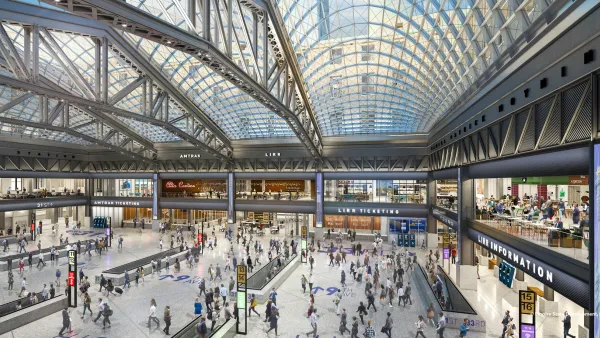With parking limited around the stadium for yesterday’s Super Bowl, attendees relied on the New York region’s transit system to get to and from the game. After months of worry about the weather, mass transit was the Least Valuable Player on game day.
In a regrettable failure on the nation’s biggest stage, one of the defining images of a forgettable Super Bowl will be hordes of attendees swarming transit platforms in futile attempts at ingress and egress.
The Super Bowl was billed as the “first ever Mass-Transit Super Bowl”: “With parking spaces at the stadium severely restricted for the game, Super Bowl organizers decided to rely heavily on trains and buses, which are usually used on a considerably smaller scale for Jets and Giants games,” reports Matt Flegenheimer.
In another article, Mike Frassinelli and Ryan Hutchins claim the 28,000 people who used transit to attend the game totaled “far more people than officials had expected, and it proved too much for the transit system to handle.”
Taking the brunt of the traffic (and the complaints) was New Jersey Transit: “Crowds boarded en masse at Pennsylvania Station in Manhattan and traveled to Secaucus Junction, where people were then required to show game tickets before boarding connecting trains to the stadium, which is in East Rutherford. It took a while,” says Flegenheimer. Delays were so bad after the game, in fact, that attendees were encouraged to stay in the stadium. Lines weren’t fully clear until 2.5 hours after the game. The transit system even lucked out that the game wasn’t closer: “the situation would probably have been worse if the game had been closer and a lot of Denver fans had chosen to stay to the end."
FULL STORY: ‘Mass-Transit Super Bowl’ Hits Some Rough Patches in Moving Fans

National Parks Layoffs Will Cause Communities to Lose Billions
Thousands of essential park workers were laid off this week, just before the busy spring break season.

Retro-silient?: America’s First “Eco-burb,” The Woodlands Turns 50
A master-planned community north of Houston offers lessons on green infrastructure and resilient design, but falls short of its founder’s lofty affordability and walkability goals.

Delivering for America Plan Will Downgrade Mail Service in at Least 49.5 Percent of Zip Codes
Republican and Democrat lawmakers criticize the plan for its disproportionate negative impact on rural communities.

Test News Post 1
This is a summary

Test News Headline 46
Test for the image on the front page.

Balancing Bombs and Butterflies: How the National Guard Protects a Rare Species
The National Guard at Fort Indiantown Gap uses GIS technology and land management strategies to balance military training with conservation efforts, ensuring the survival of the rare eastern regal fritillary butterfly.
Urban Design for Planners 1: Software Tools
This six-course series explores essential urban design concepts using open source software and equips planners with the tools they need to participate fully in the urban design process.
Planning for Universal Design
Learn the tools for implementing Universal Design in planning regulations.
EMC Planning Group, Inc.
Planetizen
Planetizen
Mpact (formerly Rail~Volution)
Great Falls Development Authority, Inc.
HUDs Office of Policy Development and Research
NYU Wagner Graduate School of Public Service



























